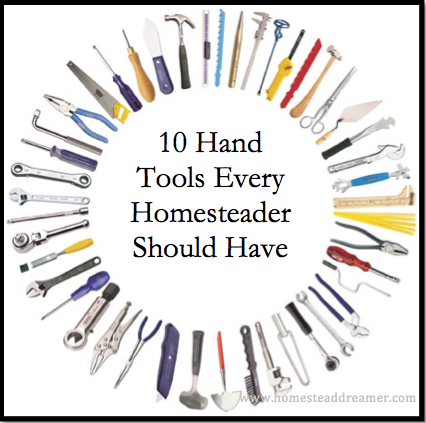Homesteading without hand tools is like trying to go scuba diving without an air tank. It’s just not how you do it if you want to do it right.
I’m not your typical female. I really don’t care for shopping overall (especially clothes shopping) nor do I spend hours and thousands of dollars getting my hair and nails done. The older I get, the less ‘feminine’ I seem to be and I’m OK with that. It happens to the best of us. I was talking with some friends the other day about tools and one of the guys commented on their dream of being able to walk into a Home Depot or Lowe’s or something and buy absolutely any tool they wanted. I had to laugh because to me, that sure sounded like a good time! I, too, would actually look forward to shopping if I was set loose in a home building supply store, or a firearm store, or a lot filled with things from tractors to ATVs. That is my kind of shopping! As I daydreamed about what kinds of tools I would toss into the basket, it occurred to me that there are certain tools that are absolute ‘must haves’ if you are homesteading. Many of these tools apply to preppers and survivalists, too.
Whenever we plan the purchase of a power tool in the budget, we also make sure we can purchase the hand tool equivalent. We are slowly building up our tool shed and WOW it can be expensive! We do not buy the super high end stuff, but neither do we go for bargain tools. We hope that by spending a little more, we get an item that with proper maintenance will last us for the next 10+ years.
I say “homesteader” in the title of this article but this is one area where preparedness, survival, self-sufficiency, and homesteading lines are blurred. I am sure there are many other hand tools that could be added to this list. Given in no particular order, here are the 10 hand tools that every homesteader should have (and know how to use!).
- Axe
- Hand Drill
- Hammer
- Shovel
- Vice Grip/Clamp
- Screwdrivers
- Wrench Set
As I was going over the projects we have done in the last couple of years, it occurred to me that overall, tools serve one of three purposes: Harvesting resources, repairing or taking apart something, and putting something together. Most tools serve all three functions and that, I believe, is the key. An axe can chop down trees (harvest resources), take things apart (demo), or put things together (using the back end to hammer nails or move something into place). A hand planer can shape and reform old wood to be used in a new way, not to mention help with creating smooth surfaces on furniture pieces.
Even more important than having these hand tools is being proficient with the use of them! What good is a hand saw if you don’t know how to properly use it and end up breaking it? If you don’t know how to handle an axe, you could end up doing serious damage to yourself or others. Using an axe to chop wood isn’t rocket science, that is true, but there is a skill set that goes along with it. I used to think I was pretty good with an axe overall… until I watched my husband chop up some wood on our first camping trip. Whenever I come across a chunk of wood with a large knot, I tend to put it back to be used for an ‘all-night burner.’
Wanting to show off my “Alaskan Woman” skills, I chopped up a bunch of rounds and got a nice stack of wood going. Well, Mr. Dreamer pulled out a couple of the larger pieces and, not unkindly, showed me how to work around the knots and with the grain of the wood to make it less labor intensive. He grew up with a wood stove as the primary source of heat and had pretty much mastered all things firewood related by the time he was 12. Lucky me!
The last step to having hand tools and knowing how to use them would be the maintenance of them. It’s all fine and dandy to have and know how to use a hand tool however, most homesteaders cannot just head out to the store and buy new tools. From a disaster/preparedness point of view, it’s important to be able to make repairs to the tools, too! This is an area that we are working on as best as we can. We know there are certain things that we would not be able to repair or craft a replacement on our own and that is OK. Knowing and accepting your limits is another important part of being a homesteader, prepper, or survivalist!
What tools would YOU add to this list? Leave us a comment below or head over to our Facebook page and leave one there!





Add chisels (for both woos and steel), steel punches (both hollow and solid), and a pick axe. Good list, regardless.
(Ugh, WOOD or steel….)
Thanks Mort! I agree with those additions completely. You could makeshift a few other tools to do the sane functions, too.
A hand crank mixer for the kitchen of course
Absolutely!!
You forgot pliers. We have a pair in every rig & in the shop & I have a pair of fencing pliers in the kitchen drawer – so handy:)
sledge hammer, crow bar, wedges and a block and tackle, rope, 5′ pry bar, hoe, a set of metal taps. socket wrench set and the knowledge to use all of them
Agreed on all of these suggestions. Especially the skills to use them part. VERY important! Thanks for the comment and adding to the list. 🙂